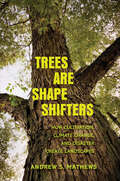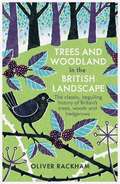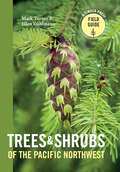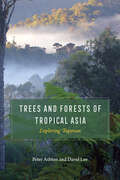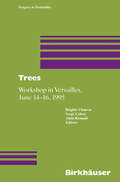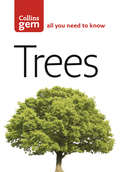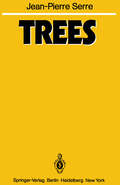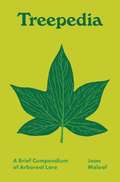- Table View
- List View
Trees I (Biotechnology in Agriculture and Forestry #1)
by Y. P. BajajBiotechnology has come to a stage where, by replacing some of the age old practices of breeding, it can produce novel and improved plants and animals that can better serve human beings and their purposes. The techniques of cellular and subcellular engineering, such as gene splicing and recombinant DNA, cloning, hybridomas and monoclonal anti bodies, production of human insulin, protein engineering, industrial fermentation, artificial insemination, cryopreservation and ovum trans fer, plant tissue culture and somatic hybridization, nitrogen fixation, phytomass production for biofuels etc have advanced greatly in the past decade, due to the availability of better equipment and the consolida tion of knowledge. Product orientation has removed biotechnology from the area of pure academic interest to one of utility where the final product is a spur to action. Businesses have started pouring money into projects, which has aided greatly in improving equipment, information exchange, and arousing the interest and imagination of the public. The common goal of science, industry and the public opens wide vistas and great hopes for biotechnology. The business of biotechnology addresses itself to issues of factory farming, technology transfer, joint ventures, international cooperation and to specific topics as well as the produc tion of diagnostic kits. Industry is particularly concerned with the phar maceutical field and microbial biotechnology from which profitable return§ can accrue. Commercial interests have led to better management practices and systematisation.
Trees at their Upper Limit: Treelife Limitation at the Alpine Timberline (Plant Ecophysiology #5)
by Gerhard Wieser Michael TauszThe product of decades of intensive research into alpine timberlines, this book presents a complete synthesis of current knowledge on the ecophysiology of tree growth and survival on high mountains in Europe. Amid growing realization that high elevation forests have a crucial role to play in protection against natural hazards, this book sets a new standard for research on the ecophysiology of trees growing at the alpine timberline.
Trees Are Shape Shifters: How Cultivation, Climate Change, and Disaster Create Landscapes (Yale Agrarian Studies Series)
by Andrew S. MathewsAn exploration of the anthropogenic landscapes of Lucca, Italy, and how its people understand social and environmental change through cultivation In Italy and around the Mediterranean, almost every stone, every tree, and every hillside show traces of human activities. Situating climate change within the context of the Anthropocene, Andrew Mathews investigates how people in Lucca, Italy, make sense of social and environmental change by caring for the morphologies of trees and landscapes. He analyzes how people encounter climate change, not by thinking and talking about climate, but by caring for the environments around them. Maintaining landscape stability by caring for the forms of trees, rivers, and hillsides is a way that people link their experiences to the past and to larger scale political questions. The human-transformed landscapes of Italy are a harbinger of the experiences that all of us are likely to face, and addressing these disasters will call upon all of us to think about the human and natural histories of the landscapes we live in.
Trees and Woodlands (British Wildlife Collection)
by George PeterkenFeatures almost 300 colour photographs and brings together more than 60 years of research by a leading voice in British woodland ecology. Trees define woodland. They provide a complex, multi-layered habitat for a great range of wildlife, but they are also wildlife themselves, reacting to their circumstances and each other. Woodlands are important to people, supplying timber, food and fuel, accumulating carbon, and offering places of refuge and refreshment. But they are also under threat: some stand in the way of 'progress', and all are becoming increasingly vulnerable to disease and climate change.In Trees and Woodlands, George Peterken brings together decades of scientific research, while also incorporating his personal experiences, to explore the ecology, nature conservation and wider cultural value of our native trees and shrubs, and the various ways they have combined as woodland. Peterken accepts that all woodlands have been shaped by people as well as nature, and he describes the long history of use and management and how this has influenced woodland wildlife. Woodlands have also contributed to our art, beliefs and social attitudes, and this too is examined. He concludes by asking, what next for Britain's trees and woodlands? He advocates woods being managed and their timber and small wood being put to good use, but recognises that this is all part of a larger question: the future of ourselves. Containing nearly 300 photographs, and interspersed with box texts describing the history and ecology of representative woods across Britain, this is a commentary on trees, woodlands and our relationship with them from one of our most highly regarded forest ecologists.
Trees and Woodlands (British Wildlife Collection)
by George PeterkenFeatures almost 300 colour photographs and brings together more than 60 years of research by a leading voice in British woodland ecology. Trees define woodland. They provide a complex, multi-layered habitat for a great range of wildlife, but they are also wildlife themselves, reacting to their circumstances and each other. Woodlands are important to people, supplying timber, food and fuel, accumulating carbon, and offering places of refuge and refreshment. But they are also under threat: some stand in the way of 'progress', and all are becoming increasingly vulnerable to disease and climate change.In Trees and Woodlands, George Peterken brings together decades of scientific research, while also incorporating his personal experiences, to explore the ecology, nature conservation and wider cultural value of our native trees and shrubs, and the various ways they have combined as woodland. Peterken accepts that all woodlands have been shaped by people as well as nature, and he describes the long history of use and management and how this has influenced woodland wildlife. Woodlands have also contributed to our art, beliefs and social attitudes, and this too is examined. He concludes by asking, what next for Britain's trees and woodlands? He advocates woods being managed and their timber and small wood being put to good use, but recognises that this is all part of a larger question: the future of ourselves. Containing nearly 300 photographs, and interspersed with box texts describing the history and ecology of representative woods across Britain, this is a commentary on trees, woodlands and our relationship with them from one of our most highly regarded forest ecologists.
Trees and Woodland in the British Landscape: The Complete History Of Britain's Trees, Woods And Hedgerows
by Dr Oliver RackhamA beautifully written classic of nature writing.'A masterly account...of supreme interest...a classic' Country LifeLong accepted as the best work on the subject, Oliver Rackham's book is both a comprehensive history of Britain's woodland and a field-work guide that presents trees individually and as part of the landscape.From prehistoric times, through the Roman period and into the Middle Ages, Oliver Rackham describes the changing character, role and history of trees and woodland. He concludes this definitive study with a section on the conservation and future of Britain's trees, woodlands and hedgerows.
Trees and Wood in Dendrochronology: Morphological, Anatomical, and Tree-Ring Analytical Characteristics of Trees Frequently Used in Dendrochronology (Springer Series in Wood Science)
by Fritz H. SchweingruberThe science of dendrochronology has grown significantly in the past 20 years. In the 1950s and 1960s, interest in the subject was limited to only a handful of scientists who perceived in dendrochronology a "l'art pour l'art". Today, however, specialists from many different fields recognize and are pursuing the problems of dendrochronology. Tree-ring research has acquired a permanent role in the various sciences of archeology, history, geology, ecology, and climatology. The founders of dendrochronology themselves were of varied scientific backgrounds and interests. For example, A. E. Douglass in the United States was an astronomer, B. Huber in Germany a forest-biologist, and F. N. Shvedov in Russia a climatologist. Today the spectrum is even broader. Many den drochronologists are authorities in mathematics, archeology, history, forestry, botany, wood technology, ecology geography, geology, etc. It is, therefore, understandable that it has become almost impossible for one individual to encompass the entire field. Bitvinskas (1974), Fritts (1976), Schweingruber (1983), and Mitsutani (1990) have attempted, each guided by his own interests, to provide at least an overview of the field. Recently, individual aspects have been presented by groups of authors in books edited by Fletscher (1978), Hughes et al. (1982), Jacoby and Hornbeck (1987) and Bradley and Jones (1992). It is very likely that in the future summaries covering each branch of dendrochronology will be published.
Trees And Timber In The Anglo-saxon World (Medieval History and Archaeology)
by Michael D. J. Bintley Michael G. ShaplandTrees were of fundamental importance in Anglo-Saxon society. Anglo-Saxons dwelt in timber houses, relied on woodland as an economic resource, and created a material culture of wood which was at least as meaningfully-imbued, and vastly more prevalent, than the sculpture and metalwork with which we associate them today. Trees held a central place in Anglo-Saxon belief systems, which carried into the Christian period, not least in the figure of the cross itself. Despite this, the transience of trees and timber in comparison to metal and stone has meant that the subject has received comparatively little attention from scholars. Trees and Timber in the Anglo-Saxon World constitutes the very first collection of essays written about the role of trees in early medieval England, bringing together established specialists and new voices to present an interdisciplinary insight into the complex relationship between the early English and their woodlands. The woodlands of England were not only deeply rooted in every aspect of Anglo-Saxon material culture, as a source of heat and light, food and drink, wood and timber for the construction of tools, weapons, and materials, but also in their spiritual life, symbolic vocabulary, and sense of connection to their beliefs and heritage. These essays do not merely focus on practicalities, such as carpentry techniques and the extent of woodland coverage, but rather explore the place of trees and timber in the intellectual lives of the early medieval inhabitants of England, using evidence from archaeology, place-names, landscapes, and written sources.
Trees and Shrubs of the Pacific Northwest (A Timber Press Field Guide)
by Mark Turner Ellen KuhlmannAs a part of the Timber Press Field Guide book series, Trees and Shrubs of the Pacific Northwest is the must-have book for accurate identification of regional flora.
Trees and Hierarchical Structures: Proceedings of a Conference held at Bielefeld, FRG, Oct. 5–9th, 1987 (Lecture Notes in Biomathematics #84)
by Andreas Dress Arndt Van HaeselerThe "raison d'etre" of hierarchical dustering theory stems from one basic phe nomenon: This is the notorious non-transitivity of similarity relations. In spite of the fact that very often two objects may be quite similar to a third without being that similar to each other, one still wants to dassify objects according to their similarity. This should be achieved by grouping them into a hierarchy of non-overlapping dusters such that any two objects in ~ne duster appear to be more related to each other than they are to objects outside this duster. In everyday life, as well as in essentially every field of scientific investigation, there is an urge to reduce complexity by recognizing and establishing reasonable das sification schemes. Unfortunately, this is counterbalanced by the experience of seemingly unavoidable deadlocks caused by the existence of sequences of objects, each comparatively similar to the next, but the last rather different from the first.
Trees and Forests of Tropical Asia: Exploring Tapovan
by Peter Ashton David LeeInformed by decades of researching tropical Asian forests, a comprehensive, up-to-date, and beautifully illustrated synthesis of the natural history of this unique place. Trees and Forests of Tropical Asia invites readers on an expedition into the leafy, humid, forested landscapes of tropical Asia—the so-called tapovan, a Sanskrit word for the forest where knowledge is attained through tapasya, or inner struggle. Peter Ashton and David Lee, two of the world’s leading scholars on Asian tropical rain forests, reveal the geology and climate that have produced these unique forests, the diversity of species that inhabit them, the means by which rain forest tree species evolve to achieve unique ecological space, and the role of humans in modifying the landscapes over centuries. Following Peter Ashton’s extensive On the Forests of Tropical Asia, the first book to describe the forests of the entire tropical Asian region from India east to New Guinea, this new book provides a more condensed and updated overview of tropical Asian forests written accessibly for students as well as tropical forest biologists, ecologists, and conservation biologists.
Trees and Forests of Tropical Asia: Exploring Tapovan
by Peter Ashton David LeeInformed by decades of researching tropical Asian forests, a comprehensive, up-to-date, and beautifully illustrated synthesis of the natural history of this unique place. Trees and Forests of Tropical Asia invites readers on an expedition into the leafy, humid, forested landscapes of tropical Asia—the so-called tapovan, a Sanskrit word for the forest where knowledge is attained through tapasya, or inner struggle. Peter Ashton and David Lee, two of the world’s leading scholars on Asian tropical rain forests, reveal the geology and climate that have produced these unique forests, the diversity of species that inhabit them, the means by which rain forest tree species evolve to achieve unique ecological space, and the role of humans in modifying the landscapes over centuries. Following Peter Ashton’s extensive On the Forests of Tropical Asia, the first book to describe the forests of the entire tropical Asian region from India east to New Guinea, this new book provides a more condensed and updated overview of tropical Asian forests written accessibly for students as well as tropical forest biologists, ecologists, and conservation biologists.
Trees: Workshop in Versailles, June 14–16 1995 (Progress in Probability #40)
by Brigitte Chauvin Serge Cohen Alain RouaultFor the first time, the very different aspects of trees are presented here in one volume. Articles by specialists working in different areas of mathematics cover disordered systems, algorithms, probability, and p-adic analysis. Researchers and graduate students alike will benefit from the clear expositions.
The Trees: A Novel
by Percival EverettSunday Times Fiction Book of the Year 2022Winner of the Bollinger Everyman Wodehouse Prize for Comic Fiction 2022Sunday Times Novel of the Year 2022When the rural town of Money, Mississippi is beset by a series of brutal murders, a pair of detectives from the Mississippi Bureau of Investigation arrive, only to be met with resistance from the local sheriff, his deputy, the coroner, and a mob of racist white townsfolk. This, they expect. Less predictable, however, is the second corpse which appears at each crime scene: that of a man resembling Emmett Till, the young Black boy lynched in the same town sixty-five years earlier. As a spate of copycat killings spreads across the country, what begins as a murder investigation soon becomes a journey into the soul of America’s violent past.‘Everett has mastered the movement between unspeakable terror and knock out comedy.’ The New York Times
Trees (Collins Gem)
by Alastair FitterThe ideal portable companion, the world-renowned Collins Gem series returns with a fresh new look and updated material.
Trees: 10 Things You Should Know
by Carolyn FryDiscover the wonders at the centre of our planet's ecosystem.In ten short and accessible essays, science and nature writer Carolyn Fry takes us on an awe-inspiring journey of the Earth's lungs. From what makes a plant a tree and the incredible impact of forests, to how trees are under attack and what we can do to save them, this book will enthral and inform on the monumental power of the humble tree.Trees: 10 things you should know is an essential introduction to why trees are so important, and why our lives depend on them!
Trees: The Mechanical Design
by Gerhard C. MattheckThe beauty of a knotty oak tree is different from that of a lovely flower. It is the rough beauty of an old soldier's face showing the traces of wind and sun, of harm and of victory, bearing the scars of bygone battles. It is different from the fragile, delicate beauty of a young girl which is evident to anyone at first sight. The beauty of an old and crippled tree is hidden unless perceived by the alert eye which is able to fancy or rather discern the hard trials of life the tree has ex perienced. Contemplating trees in this way is not much different from busying oneself with physiognomies, i.e. with the art of judging character from the features of the human face. Physiognomies is often considered a dubious science, but is prac ticed every day in human communication by everybody from early childhood to old age. Although we all are able to discern the angrily furrowed brow, the laughing crow's-feet below the eyes, the arrogant harsh lines around the nose, the hard narrow mouth, the gluttonous lip, and the secret eye of the silent ob server, we would never admit to rely on such seemingly doubtful methods.
Trees (Springer Monographs In Mathematics Ser.)
by Jean-Pierre SerreThe seminal ideas of this book played a key role in the development of group theory since the 70s. Several generations of mathematicians learned geometric ideas in group theory from this book. In it, the author proves the fundamental theorem for the special cases of free groups and tree products before dealing with the proof of the general case. This new edition is ideal for graduate students and researchers in algebra, geometry and topology.
The Trees
by Ali ShawA compulsive, mesmerising and wildly imaginative novel in the vein of Pan's Labyrinth and Station Eleven from the award-winning author of The Girl with Glass FeetThere came an elastic aftershock of creaks and groans and then, softly softly, a chinking shower of rubbled cement. Leaves calmed and trunks stood serene. Where, not a minute before, there had been a suburb, there was now only woodland standing amid ruins…There is no warning. No chance to prepare. The trees arrive in the night: thundering up through the ground,transforming streets and towns into shadowy forest. Adrien Thomas has never been much of a hero. But when he realises that no help is coming, he ventures into this unrecognisable world. Alongside green-fingered Hannah and her teenage son Seb, Adrien sets out to find his wife and to discover just how deep the forest goes. Their journey will take them to a place of terrible beauty and violence, to the dark heart of nature and the darkness inside themselves.
The Trees
by Ali ShawThe Trees. They arrived in the night: wrenching through the ground, thundering up into the air, and turning Adrien's suburban street into a shadowy forest. Shocked by the sight but determined to get some answers, he ventures out, passing destroyed buildings, felled power lines, and broken bodies still wrapped in tattered bed linens hanging from branches. It is soon apparent that no help is coming and that these trees, which seem the work of centuries rather than hours, span far beyond the town. As far, perhaps, as the coast, where across the sea in Ireland, Adrien's wife is away on a business trip and there is no way of knowing whether she is alive or dead. When Adrien meets Hannah, a woman who, unlike him, believes that the coming of the trees may signal renewal rather than destruction and Seb, her technology-obsessed son, they persuade him to join them. Together, they pack up what remains of the lives they once had and set out on a quest to find Hannah's forester brother and Adrien's wife--and to discover just how deep the forest goes. Their journey through the trees will take them into unimaginable territory: to a place of terrible beauty and violence, of deadly enemies and unexpected allies, to the dark heart of nature and the darkness--and also the power--inside themselves.
Trees (Wordcatcher Modern Fiction)
by Sam SmithHazel is going to die. But when? After the steroid treatments that make her into a slip-slopping bag of water? Or after discovering that her biological father is the millionaire, Gustaf Eriksson, a man obsessed with reforesting England? Or will it be when her mother gives up her café and herself becomes involved with The Tree Prospectus? Gustaf Eriksson made his fortune as a pop-music promoter, now in his tree-planting retirement he writes and occasionally performs haiku with one of his old bands. Or could this be a 17-syllable red herring? Will Hazel die after she leaves her sedentary game-playing boyfriend and moves in with her mother, who has separated from her accountant husband? In the background lurks the threat of Gustaf Eriksson’s son, a reputedly violent individual.
Trees (Collins New Naturalist Library)
by Peter ThomasA long-awaited volume in the New Naturalist series examining the trees of Britain.
Trees: Biotechnological Approaches for Propagation of a Multipurpose Tree, Balanites aegyptiaca Del.
by Ankita Varshney Mohammad AnisPlant tissue culture is an essential component of Biotechnology which has gained unbeatable recognition in plant sciences for successful micropropagation and improvement of plant species, leading to the commercial application. A number of plant species have been investigated around the globe. This book presents current research on the application of in vitro technology in the improvement of Balanites aegyptiaca Del., a medicinal plant of semi-arid tropics. The worldwide importance of forestry, summed to the lengthy generation cycles of tree species, makes unavoidable development of new technologies that complement conventional tree breeding programmes in order to obtain improved genotypes. Recently, a new set of tools has become available in the past 20 years that combined with traditional plant breeding will allow scientists to generate products that are genetically improved varieties of the future. These set of tools come under the general title of ‘Biotechnology’. The three specific biotechnological tools have been successfully used in several programmes of plant conservation, namely, tissue culture techniques for in vitro propagation, the use of molecular markers to assess the degree of variability among population and techniques of long-term conservation such as encapsulation and cryopreservation. Plant tissue culture techniques are particularly relevant and become an alternative not only for large scale propagation of individuals that are threatened, reduce production costs and increase gains to the industry, but also to provide ecological advantages as in phytoremediation or in the establishment of artificial plantings in weed infested site. The book gives a complete documentation of the results and demonstration of Balanites aegyptiaca conducted by the authors over the past 5 years. The end-to-end approach developed through plant tissue culture techniques is reflected in the book and there has been a successful transfer of technology from lab to field. The authors hope that this information would provide valuable data and also be a reference material for future research activities in this area.
Treepedia: A Brief Compendium of Arboreal Lore (Pedia Books)
by Joan MaloofA captivating A–Z treasury for the tree hugger in all of usTreepedia is an entertaining and fact-filled illustrated compendium of tree lore. Featuring nearly 100 entries—on topics ranging from tree ecology and conservation to the role of trees in religion, literature, art, and movies—this enticing collection is a celebration of all things arboreal.In this charming book, Joan Maloof explains the difference between a cedar and a cypress, and reveals where to find the most remarkable trees on the planet. She tells the story behind the venerable Bodhi Tree, and describes peculiar species like baobabs and Fitzroya. Maloof profiles legendary conservationists such as Julia "Butterfly" Hill, John Muir, Wangari Maathai, and Ken Wu. She discusses reforestation, proforestation, emerald ash borers, the ents from The Lord of the Rings, culturally modified trees, the ill-fated and controversial Redwood Summer, and much more. The book's portable size makes it the perfect travel companion no matter where your love of the forest may lead you.With enchanting illustrations by Maren Westfall, Treepedia is a fun and informative book that is guaranteed to inspire anyone who has ever enjoyed a walk in the woods.Features a real cloth cover with an elaborate foil-stamped designUses 100 percent recycled, uncoated, wood-free paper


